This photo shows a small New Jersey town some time around the year 1781. Although the American War for Independence has been going on for a few years, this town remains neutral and relatively unaffected by the skirmishes between the Rebels and the Crown.
It is early summer, and the spring crops have been harvested. Grains will come later in the fall. Excess crops will be sold to either the Americans or the Brits, whoever pays the highest price.

A British regiment enters the town. They are a foraging party gathering food and supplies for the British in Manhattan and Staten Island. Usually they don't come far west of Elizabethtown, New Jersey, but this time they have come all the way to Connecticut Farms and near Springfield.
Apparently, the Loyalists of New York cannot provide enough goods for Cornwallis' army. The British foragers have come to take crops and livestock from the inhabitants of New Jersey.
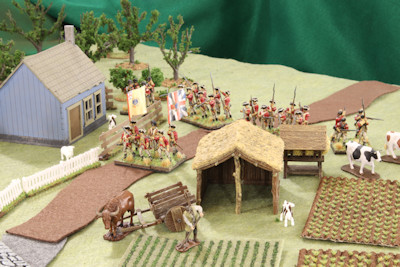
The New Jerseyans have had enough of this stealing and looting. Cannons on the Watchung hills fire to warn of the encroaching British military. Soldiers on horseback race west to call out the militia and send the British home.
What numbers! Nearly two regiments arrive quickly from the west of Connecticut Farms. The number of militia is nearly double the size of the British regiment. Surely the Brits will be sent a strong message and go back to Staten Island.
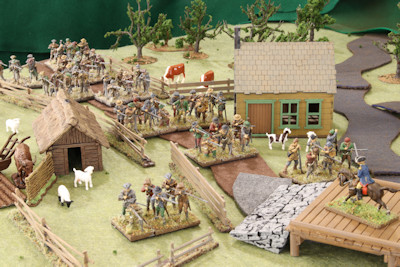
There is a standoff on bridges on the branches of the Rahway River. The militia attempts to scare off the British by show of numbers.
But the British commander Mathew is having none of this intimidation. He brings forward his Hessian ally Knyphausen and his regiment of grenadiers. The highly trained British line infantry and Hessian grenadier infantry are certainly more than a match for the local militia.
To teach the rebels a lesson, the British start setting fire to Connecticut Farms church, and some of the houses and farms. The rebels should learn to be good British subjects and more loyal to the Crown.
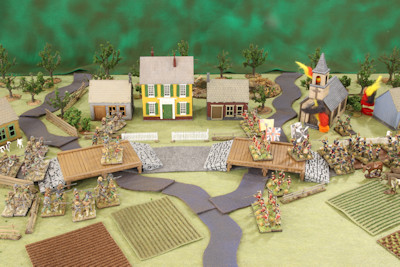
The Americans have had enough. The militia open fire on the British.
And a good volley it is! Several British infantry have fallen in the first round. The militia presses forward to get in more shots.
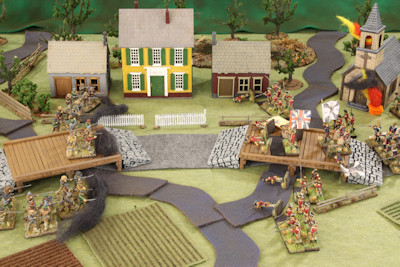
The British and the Hessians return fire. Many rebel militia fall dead to the return volley.
The battle hangs in the balance. Both sides have taken casualties. Which side will break and run first? Whoever holds steady will win the battle and the loyalty of this area of New Jersey.
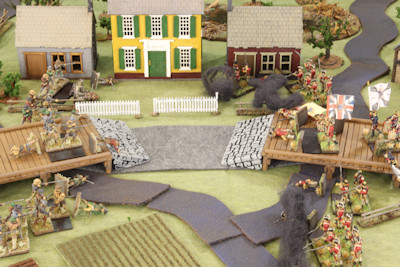
At this point British commander Mathew unveils a nasty surprise. The British cannons have moved into position on Galloping Hill Road. The cannons are in range of the Connecticut Farms and the bridges leading to Springfield, New Jersey.
The cannoneers open fire on the American rebels down the road.
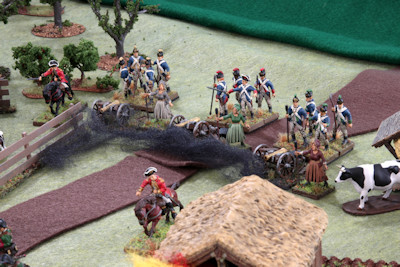
The American militia casualties are heavy. The bodies and blood of the local merchants, farmers, woodworkers, laborers, husbands, and sons lie all over the road and the bridge.
The resolve of the rebels has been broken. They turn and run to the west. West to the wilderness and safety of the Watchung hills.

Suddenly from west of the Watchungs, from the winter encampment of Morristown, comes the American General George Washington. Washington leads a regiment of Continental Army infantry.
The French allies led by Lafayette in their white uniforms follow side by side with the Americans.
At the rear, the Americans set up their own cannon regiment. The cannons begin long range shelling of the British and Hessians.
The American militia regains their composure and return and fight with the allied American force.
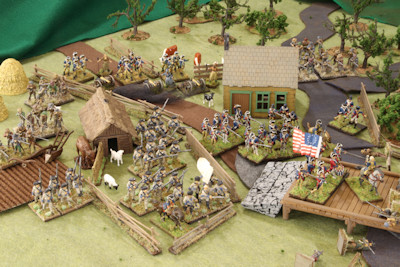
The British and Hessians are outnumbered and outgunned. The trained Continental Army and French soldiers are a match, and the American militia was able to inflict early casualties and tip this battle towards the Americans.
The British and Hessians flee back east to Elizabethtown and Staten Island.
Both sides claim victory for this battle. The British claim they successfully destroyed rebel infrastructure, inflicted heavy casualties, and sent a message to the rebels. The Americans claim they have held onto their land, repelled the British invasion, and prevented further attacks in New Jersey.
The American War for Independence rages on!
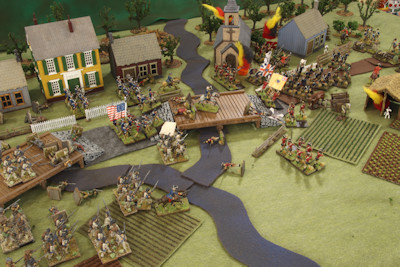
Making the Miniatures
Thanks for reading about the tabletop battle. The rest of this article is about making the figures and the scenery. This is a continuation of an earlier AWI Battle article, but there are more figures, new scenery, and different unit types.
To the left is a photo of a regiment of Colonial Militia soldiers. These miniatures (as are most in the article) are 28 mm plastic soldiers from Warlord Games. Warlord Games has a large line of historical miniatures, but these figures are intended for using their rule set for battles in the years 1700-1900 Black Powder.
A box of Militia has 3 sprues of 10 bodies with various heads, arms, and weapons for a total of 30 soldiers.
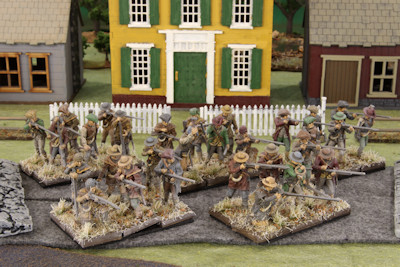
This is the left side view of the Colonial Militia soldiers. Notice the various hats: tricornes, round brimmed hats, and knitted toques. There are also one sergeant head per sprue with the pinned brimmed hat. The bodies come in colonial street clothes or fringed hunting shirts. The variety is great. Here I have made a mix.
Unfortunately, I got a bit anxious with the clear matte varnish. I sprayed it in relatively high humidity (around 80%), and this caused the varnish to become hazy and frosty. They look a bit dusty and less colorful than my other miniatures or say the buildings in the background. As a rule, you should spray in moderate temperatue (50 to 85 fahrenheit) and low humidity (less than 50%, ideally around 25%).
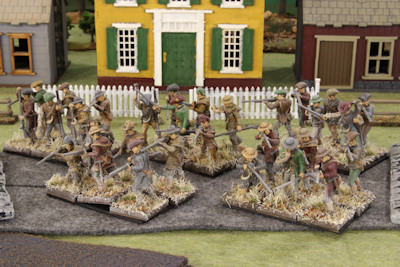
Here is the second box of American Militia soldiers. Your might notice that the colors are a bit more saturated and the grass a little less frosted than the last militia regiment. Always spray any clear coat is low humidity, 50% or less.
A word about the bases. For the Black Powder II American War for Independence rules, I put all these figures on 20 by 20 mm square bases. First the miniature figure is glued to the plastic base that comes with the box of miniatures. Then I epoxy a thin ferrous metal base from Wargames Accessories to the plastic base. The heavy metal base weights the miniature so that the soldier most always stand up and does not knock over easily.
Then I make a larger rectangular tray for 4, 6, or 8 figures which are 40 by 40, 40 by 60, or 40 by 80 mm. The trays are thin plywood from Litko Aero. The plywood gets a thin magnetic sheet (like the 1 mm flexible labels that adhere to car doors) the same size as the tray. Thus you can easily move figures from box to table top, but you can also pull individual figures off the tray.
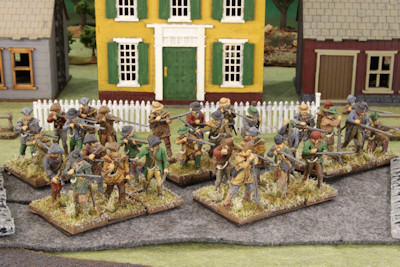
This is the left side view of the second group of American Militia miniatures.
I have another regiment of Militia waiting in boxes. They are likely to be in the next round of photos.
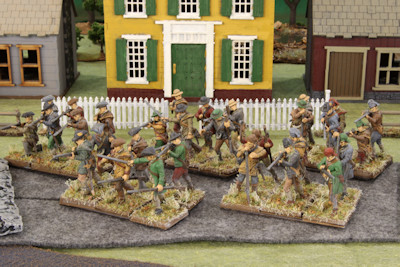
This photo shows the American leaders on horseback. Two are included in each box of Warlord Games Field Artillery and Commanders. Thus from the six commanders in this article, you see the contents of 3 boxes of field artillery.
In these boxes, there is only one horse body style, and two rider body styles, but each sprue has six heads: General Charles Cornwallis, General Sir William Howe, General Sir Henry Clinton, General George Washington, General Horatio Gates, and Major General Nathaniel Greene.
In theory, I could have made six George Washingtons on horseback. But instead I made one of each General. On the left with the green jacket facings is General Greene, in the center is George Washington, and on the right is General Gates. I really think the sculpting of the heads is excellent. The George Washington miniature really looks like George.

Here is a photo of the American commanders from the right.
The horse on the left is what is called a dun color. George's horse Blue is a gray color horse. And Gates gets to ride a brown steed.
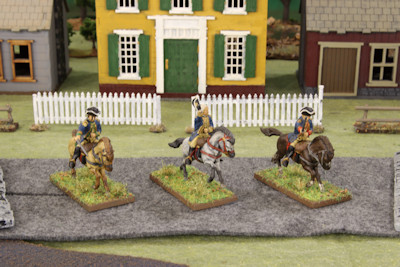
Here is a photo of the British leaders. Eccentric Howe is on the left, Commander Cornwallis is in the center, and Clinton is right.
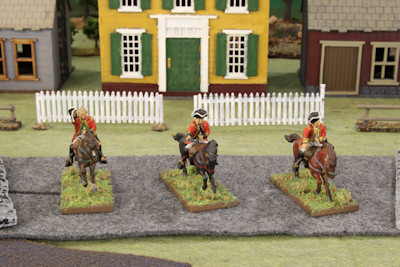
Here are the British leaders from the left.
The horse colors are brown, black, and bay.
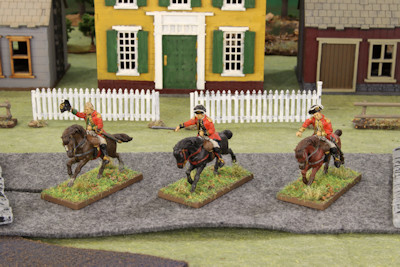
This photo shows the British cannon and the crew. Two cannons are included in each box of Warlord Games Field Artillery and Commanders. So, the six cannon in this article come from three boxes.
The cannon models have great accessories. Each cannon gets a bucket of water. and three boxes of cannonballs, powder, and fuses.
You also get four styles of crew bodies with various arms and head gear. Most of these soldiers have the crested helmet that many British cannoneers favored.
Each sprue also has a female crew member with one body style and one head. Most American are familiar with "Molly Pitcher", which was the nickname given to Mary Ludwig Hays McCauley, who took up arms after her husband was incapacitated at the Battle of Monmouth. However, American and British women often fought in battles either directly or in support of the main recruits.
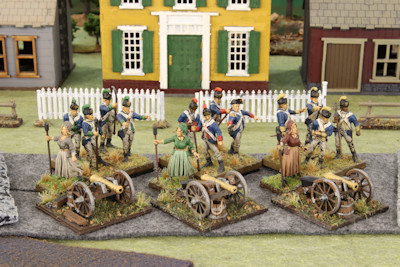
Here are the British cannon from the left.
British cannon crew often had reverse colors from their main regiment. So while the infantry were in red, the cannoneers were often in blue. I painted the three crews with different color jacket facings and helmet crests.
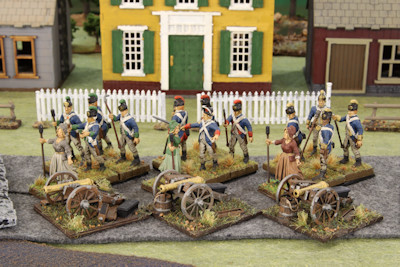
Here are the American cannons from the right.
Some of my cannon crews are painted with African American skin tones. During the American War for Independence, African Americans fought for both the American and British sides. The Americans often hired "free men", former slaves who worked or were granted their freedom. The British often hired runaway slaves and paid them with freedom at the end of the war.

Here are the American cannons from the left.
This photo is a bit blurry, and that is due to camera shake. Many of these photos are taken with no flash and studio lights. The camera is often at extremely small f16 or f22 aperture to get the in focus depth of field. The shutter speed to acheive this aperture is often 3 to 5 seconds which is too long to hold by hand, and so the camera is mounted on a tripod. However, sometimes the tripod is bumped, or the camera is still shaking after pressing the shutter. Thus the camera shake.
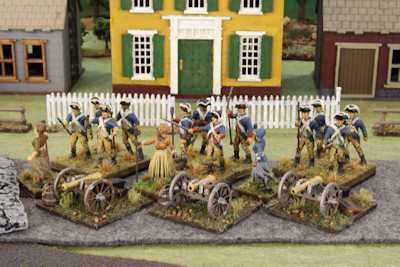
This photo shows the Hessian infantry from the left. Hessians were German soldiers that the British hired from independent areas of Germany. The German leader would hire out his army and his generals for a year or two, and in exchange the leader would get a hefty fee from the British monarch. Since the monarch of Britain was King George III who (along with his predecessor King George II) barely spoke any English and ancestrally was a German, the willingness to cooperate in this war was a given.
The soldiers in this photo wear jackets of blue and green. The dark blue is what is known as Prussian blue, a shade darker than the American blue jackets. The green jackets are worn by the light infantry, jaegers (hunters), and riflemen. These jaegars are the equivalent to modern day guerilla hit and run squads with excellent weapons. The chaps in the back are grenadiers with big mitre caps. They are typically the tallest, best equipped, and most elite soldiers of this era.
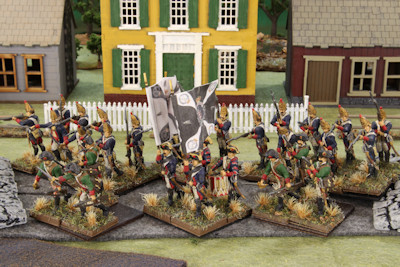
This photo shows the Hessian infantry from the right.
Drat, again this photo with its long shutter opening (4 seconds) got some camera shake. Unfortunately, you cannot see the focus on the camera display, there aren't enough pixels. Only when I get the photo to the desktop computer do I see that this photo is crap.
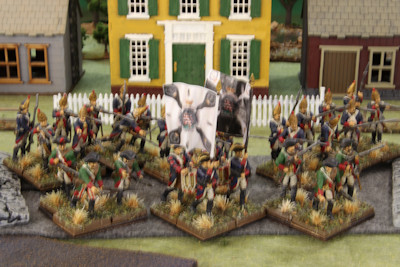
This photo shows a French infantry regiment from the right. These figures are metal minis from Perry Miniatures.
Metal miniatures are quite distinct from plastic. They tend to look chunkier, and especially the weapons appear quite primitive. However some of the metal miniature details like buttons and moustaches can be more detailed than plastics. Also metal minis don't often have interchangable parts, so it helps to find a range, such as these French, that have a variety of poses.
I have painted them in the nearly white uniforms that the French wore in the southern campigns in the Carolinas. I like the idea of an easy to distinguish unit. Note that the French did not have a national flag at this point in history. So they normally flew white or regional flags.
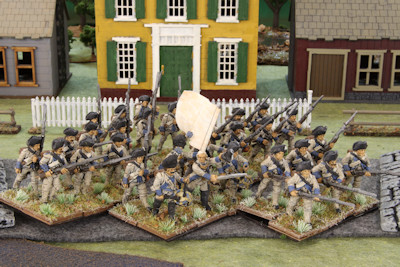
Here are the French infantry from the left.
Like the Black Powder sets of 30, I bought five bags of Perry French soldiers to get a regiment of 30.
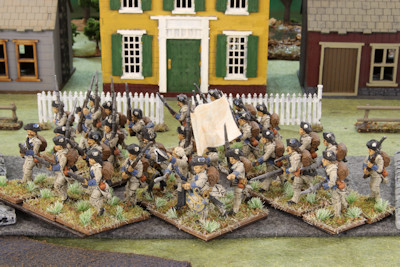
And that is all for the new soldiers for this article. Let's have a shout out to the new scenery.
In addition to the older town hall and church, I added two new houses shown in the rear. These two laser-cur medium density fiberboard (MDF) are from Sarrissa Precision North American 28 mm line. They assemble with white glue, and are easy to paint. I recommend painting the doors and window frames before assembling.
The various farmstead toys in the foreground are from Wiz Kids 4D Settings. You get a farmer, plough, cart, hay piles, manger and some fencing. Tecnically, this is a medieval farmstead, but it looks in period with the primitive farms of the American frontiers.
The rest of the scenery in these photos include felt table covering, felt road and river cutouts, model train trees from Woodland Scenics, some fences built from craft sticks, a field made from cardboard, glue, and static grass.
